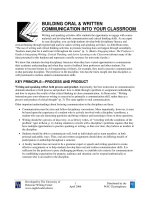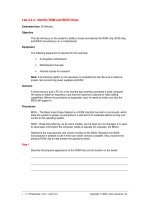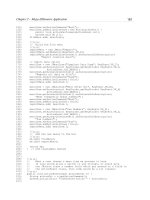Tài liệu Audience Analysis and Written Communication docx
Bạn đang xem bản rút gọn của tài liệu. Xem và tải ngay bản đầy đủ của tài liệu tại đây (121.9 KB, 13 trang )
Lecture 10.
Audience Analysis
and Written
Communication
The Concept of the Audience
Types of Professional Readers
1
Problems of Writing
Process
Resulting from specific situation:
There is no fast feedback on written
communication;
You cannot make use of non-verbal
communication;
Written message is often aimed at a
large group of people
2
Problems of Writing
Process
How people learn to write and speak:
People learn to write after learning how
to speak;
People have little practice in written
communication
3
Problems of Writing
Process
Other reasons:
Informative texts are a heterogeneous
group;
The writer has many different tasks to
carry out before he can start writing;
The text must meet many various
demands of the reader
4
The Concept of the
Audience
Various Readers => various application
purposes
Biography data => why and how the text
is used
Various purposes => various
expectations
5
Audience
Common application purpose and
common expectations
Reader’s needs = applications and
expectations
6
A key to the
audience needs
Level of knowledge about the subject
How much information should be
included
Which information should be
included
Purpose of reading
How to organize the information
7
Types of Professional
Audience
Experts
Technical workers
Managers
• ↓ Level of knowledge
• ↓ Purpose of reading
• ↓ Needs in reading
8
Experts
Level of knowledge
Very high level of knowledge
Purpose of reading
To keep and expand their professional
knowledge
To get particular answers on research
questions
To evaluate the technical content of the
plans and proposals
9
Experts: Needs in reading
Do not give detailed explanation to the source
information and definitions;
Include all details connected with any process
described in the document;
Use graphs and diagrams and figures to show
these connections, give sources of these figures;
Use titles, contents, sections and subsections
to classify and organize information;
Make sure all pages are numbered
Be sure to give citations to the sources
10
Technicians
Level of knowledge
How and why the process occurs,
why the device works or does not
work;
General technical terms to describe
process or device they know well;
Do not know well the technical
terms beyond the field of their activity
Do not know abstract or general
concepts of a process or a device
operation
11
Technicians
Purpose of reading
Learn how to do the task connected with
professional activity;
Learn to solve particular problems
connected with professional activity;
Learn about new devices connected with
professional activity;
Get new skills and knowledge to improve
their work results
12
Technicians
Needs in reading
Introductory and preliminary information
should be presented in short
Use graphs and tables;
Give instructions, where possible
Sections and instructions must be short
Section numbers and references
Give short definitions, examples or
explanations to unknown terms, devices,
instruments, etc.
13
Managers
Level of knowledge
Often have general knowledge of the
subject;
Rarely have technical knowledge in
some field;
May not know of new concepts and
achievements in the field
14
Managers
Purpose of reading
Get the information for decision making;
Realize the current situation;
Foresee future tendencies or development
in the field;
Retain their level of general knowledge;
Estimate success and efficiency of projects
and workers
15
Managers
Needs in reading
Provide key information in short
generalization;
Give information in order of its
importance;
Emphasize the information to facilitate the
decision taking;
Provide enough initial information in the
introduction;
Generalize all recommended measures and
conclusions;
Use graphs, etc. in generalizing;
Explain unfamiliar and technical terms;
Expand explanations in appendices at the
end
16
Audience Analysis
Studying the documents
Defining the audience expectations
17
Genres
The formats of presenting the
information
Particular purpose
Particular order = particular purpose
18
Three Key Schemes to Define
Genre
Ethos
Logos
Pathos
19
Ethos
Authenticity or trustworthiness
Attract and hold attention
Prove your services:
• ↓ What should I do to win and hold the reader’s attention to
have him read my work?
• ↓ What should I do to make the reader believe that my work
is professionally written and information is worth paying
attention to?
20
Ethos: aspects
• ↓ Vocabulary
• ↓ Sources
• ↓ Reputation
• ↓ Style
21
Logos
Logic
Amount of information
Type of information
What information does the reader expect to get from the text
of this genre?
How much information does the reader expect to get from
the text of this genre?
22
Logos: aspects
Facts
Definitions
Transitions
Links between the ideas
Figures
Visual ways of presenting information
23
Pathos
Emotions
• ↓ Does the reader expect me to show any emotions regarding
the topic?
• ↓ If so, how bright or ostentatious should these emotions be?
24
Pathos: aspects
Vocabulary
Comparisons
Examples:
More abstract = less emotional
Aloofer = less emotional
25
Audience Analysis:
conclusion
First define
Genres
Purpose
Then define
Ethos
Logos
Pathos
26









